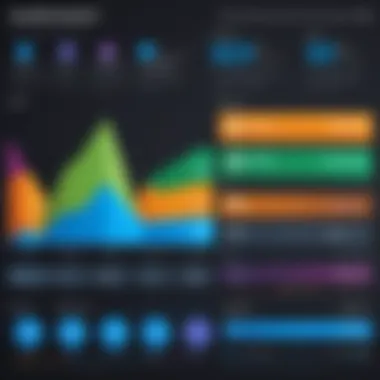Understanding Nagios XI Pricing: A Comprehensive Review


Intro
In the digital age, organizations heavily rely on efficient monitoring solutions to ensure that their IT infrastructure runs smoothly. One such software that stands out in the realm of IT monitoring is Nagios XI. This article delves into Nagios XI pricing, its features, and how it compares to other solutions available in the market. Understanding pricing and features is critical for companies seeking to make informed decisions tailored to their needs and budget.
By examining multiple aspects such as pricing tiers, performance, user experience, integrations, and support, this piece aims to provide valuable insights for business professionals and IT specialists alike.
Software Overview and Benefits
Nagios XI is a comprehensive IT infrastructure monitoring solution. It enables organizations to track the health and performance of their systems, applications, and services. Key features of Nagios XI include customizable dashboards, alerting, reporting tools, and extensive plugin support. With its user-friendly interface, administrators can quickly visualize performance metrics and potential issues.
The benefits of using Nagios XI are significant. It addresses specific needs such as:
- Real-Time Monitoring: Instant notifications on system performance, keeping IT teams informed.
- Customizability: Adaptable to various organizational requirements with its extensive plugin ecosystem.
- Integration Capabilities: Works seamlessly with other tools and platforms, enhancing existing workflows.
- Scalability: Suits different organizations, from small businesses to large enterprises.
Each feature contributes to making Nagios XI not just a monitoring tool but a comprehensive solution for maintaining operational efficiency.
Pricing and Plans
Nagios XI offers tiered pricing, which caters to a variety of organizational needs. The pricing structure includes several subscription plans, each designed for different levels of user capacity and feature access.
For example, a standard licensing model typically starts with a base price dependent on the number of monitored hosts. Additional charges apply for features such as report generation or advanced support.
Comparison with Competitors:
Nagios XI's pricing can be competitive when stacked against alternatives like Zabbix or PRTG Network Monitor. However, factors such as deployment options and included features may influence the overall value. Organizations should weigh their specific needs against the costs involved in adopting Nagios XI.
Performance and User Experience
In evaluating the performance of Nagios XI, key aspects include speed, reliability, and the overall user interface. Users report a robust performance with minimal downtime, making it a trustworthy choice for monitoring needs.
Feedback on the user experience highlights the ease of navigation and the intuitive layout of interfaces. For teams implementing Nagios for the first time, the learning curve is relatively gentle compared to some other solutions. Users find value in the dashboard configurations and real-time status checking, which streamline monitoring efforts.
Integrations and Compatibility
Nagios XI supports a wide range of integrations with various tools and platforms. This flexibility plays a crucial role in fitting smoothly into existing IT environments. Organizations can easily connect Nagios XI with systems like JIRA, Slack, or ServiceNow, among others.
Regarding compatibility, Nagios XI functions on various operating systems, including Linux and Windows servers. This broad compatibility ensures that teams can adopt this monitoring solution without major adjustments to their hardware or software environment.
Support and Resources
Customer support for Nagios XI is thorough, providing numerous options for users. Organizations can access different tiers of support based on their chosen pricing plan.common
Additional resources such as tutorials, user guides, and community forums are readily available to enhance the user experience. Many customers appreciate the documentation provided, which assists in navigating initial setups and troubleshooting.
Understanding Nagios
Understanding Nagios XI is crucial for organizations considering the implementation of a robust monitoring solution. Nagios XI stands as a comprehensive tool designed for monitoring systems, networks, and infrastructure. In this article, we will explore its features, pricing structure, and overall value proposition. Grasping the essentials of Nagios XI helps potential buyers to assess their needs and determine whether this solution aligns with their operational requirements.
An important aspect of Nagios XI is its capability to provide detailed visualization of IT systems. This allows organizations to identify issues before they escalate, thus improving operational efficiency. Moreover, Nagios XI supports a range of plugins that can be tailored to meet specific monitoring requirements, ensuring flexibility and customization.
Businesses of various sizes can benefit from understanding how Nagios XI operates. By without understanding its core functionalities, they might overlook critical aspects that could enhance their monitoring practices.
Overview of Nagios
Nagios XI is a comprehensive IT infrastructure monitoring solution designed to provide real-time insights into system performance. It serves various industries by enabling proactive management of critical systems and ensuring uninterrupted service delivery. Central to Nagios XI is its ability to monitor network health, application performance, and server status.


This solution offers a user-friendly interface that simplifies complex monitoring tasks. Users can view system metrics, set alerts for key incidents, and analyze historical data to improve decision-making processes. Its extensible architecture is designed to integrate seamlessly with third-party tools, enhancing the overall monitoring capabilities.
Key Features of Nagios
The key features of Nagios XI make it a compelling choice for organizations aiming to achieve comprehensive monitoring. These include:
- Multi-Platform Monitoring: Nagios XI can monitor various platforms, including Linux, Windows, and network devices. This flexibility ensures that all critical components are covered under one umbrella.
- Performance Graphing: The built-in graphical tools allow users to visualize key metrics over time, making it easier to identify trends and spot anomalies.
- Custom Dashboards: Users can create personalized dashboards that aggregate information relevant to their needs. This capability enhances the user experience and streamlines monitoring processes.
- Alerting System: An efficient alerting mechanism ensures that stakeholders are promptly informed of any issues that arise, thus enabling rapid response to potential downtimes.
- Comprehensive Reporting: Nagios XI provides extensive reporting options, allowing users to analyze historical performance data and assess service level agreements.
Understanding these features equips organizations with the knowledge necessary to leverage Nagios XI effectively, ensuring they maximize their investment in monitoring solutions.
Nagios Pricing Structure
Understanding the pricing structure of Nagios XI is crucial for organizations considering this monitoring solution. The structure directly influences organizational budgeting and long-term planning. There are several notable aspects that users must address. Organizations should ascertain their performance expectations, scale of deployment, and additional feature requirements. The pricing structure ultimately reflects these needs and helps clarify the total cost of ownership.
Available Pricing Tiers
Nagios XI offers different pricing tiers that cater to various organizational requirements. Each tier provides a unique set of features, designed for small to large operations.
- Essential Tier: This foundational level is suitable for small businesses or teams needing basic monitoring capabilities. It includes essential functionalities but lacks extensive support resources.
- Standard Tier: The standard offering is designed for medium-sized organizations. It adds advanced features and includes more in-depth monitoring tools, making it a more robust choice.
- Enterprise Tier: Aimed at large corporations, this tier offers the full suite of features and extensive configurability. It integrates seamlessly with other tools and systems required for extensive monitoring across large infrastructures.
Understanding which tier aligns with specific needs can maximize the benefits derived from Nagios XI.
Licensing Models Explained
Licensing models underlie the purchase options behind Nagios XI. Different models exist to accommodate diverse deployment and support needs.
- Perpetual Licensing: This model can be appealing for organizations that prefer a one-time payment. It grants ownership of the software licenses indefinitely. This is typically accompanied by a minimal annual maintenance fee for updates and support.
- Subscription Licensing: Alternatively, a subscription-based model allows organizations to utilize Nagios XI on a recurring basis, paying monthly or yearly. This model provides flexibility for those with fluctuating budgets and varying organizational needs.
Choosing the appropriate licensing model is an essential part of optimizing financial resources.
Cost of Additional Features
Beyond the base pricing tiers, there are additional features which may incur extra costs. Organizations should evaluate these features based on their requirements. Some common additional options include:
- Advanced Reporting Packs: For organizations needing comprehensive reporting capabilities, investing in advanced packs is often necessary. These cater to in-depth analytics and monitoring insights.
- Integrations and Plugins: Integrating Nagios XI with existing systems sometimes requires additional costs if specific plugins or software components are not included.
- Premium Support Services: While each tier includes standard support, investing in premium support can provide faster response times and extended service options.
These extra costs can significantly affect the total financial commitment to using Nagios XI. Careful evaluation of these costs is advised.
Comparison with Competitors
In the landscape of IT monitoring solutions, comparing Nagios XI with its competitors is essential for businesses aiming to optimize their monitoring capabilities. This section delves into critical aspects that organizations must consider when evaluating Nagios XI against other solutions available in the market.
Understanding the competitive landscape enables potential buyers to make informed decisions. It encompasses aspects such as feature sets, pricing models, user satisfaction, and overall performance. By grasping these elements, businesses can identify which solution aligns with their specific needs and budget constraints.
Nagios vs. Other Monitoring Solutions
Nagios XI shines in certain capabilities, particularly in its adaptability and robust monitoring features. Unlike some alternatives such as Zabbix or SolarWinds, Nagios XI offers a highly customizable interface, which gives users freedom in tailoring the software based on their unique requirements.
Additionally, Nagios XI provides a strong focus on network and infrastructure monitoring. This contrasts with other solutions that may focus more on application performance. For instance, while Datadog excels in cloud monitoring, Nagios has built a reputation for monitoring network performance with a detailed approach.
Regarding compatibility with other systems, Nagios XI can integrate with various plugins, making it versatile compared to other monitored tools that may have restrictive integrations. Therefore, organizations that utilize diverse technologies across their infrastructures could find this feature particularly advantageous.
However, potential users should weigh the learning curve associated with deploying Nagios XI against more user-friendly solutions, such as Paessler PRTG, which may be easier for new users to grasp but lack some advanced features.


Value for Money Analysis
When it comes to value for money, Nagios XI demonstrates a nuanced position. The pricing model reflects a balance of features and support. This model may be perceived as higher than some competitors. However, it offers significant long-term benefits with its rich functionality.
It’s important to assess how Nagios XI complements an organization’s monitoring needs over time. Savings can be seen with the high customization capabilities, allowing companies to only purchase necessary features. Organizations that require less complexity might find lower-cost solutions beneficial in the short term but could face limitations as their needs grow.
"In many cases, the initial cost of implementation should not overshadow the potential for future savings that powerful monitoring tools like Nagios XI can provide."
Factors Influencing Pricing Decisions
Understanding the factors influencing pricing decisions is crucial for any organization considering Nagios XI. The investment in monitoring solutions like Nagios XI goes beyond the initial costs; it involves evaluating several key aspects that can significantly affect the total financial commitment over time. This section explores the main elements that organizations must consider to make informed financial decisions regarding Nagios XI.
Scale of Implementation
The scale of implementation refers to the extent to which Nagios XI will be deployed within an organization. Factors such as the number of devices, servers, and applications monitored will play a significant role in determining the overall cost. Larger organizations often face higher licensing costs due to increased monitoring needs. Conversely, smaller businesses may find that a limited deployment suffices to meet their requirements and budget constraints.
Additionally, the complexity of the implementation can add extra expenses. Companies with multiple locations or operational divisions might need additional configuration and custom setup, which can incur higher costs.
Support and Maintenance Costs
Ongoing support and maintenance are essential considerations when evaluating Nagios XI pricing. Organizations must assess the potential costs associated with technical support services. Nagios XI offers different levels of support that can impact the overall expenses. Basic support might be included in the initial purchase, but companies can opt for premium support plans that guarantee faster response times and additional services.
Moreover, organizations should keep in mind the potential hidden costs associated with maintenance. Keeping the software updated and ensuring it operates smoothly often requires dedicated IT staff or consulting services, adding to the total budget.
Training and Onboarding Expenses
Training and onboarding expenses are another critical factor affecting the pricing decisions. Effective usage of Nagios XI often requires specialized knowledge and skills. Companies may need to invest in training programs for their IT staff to ensure proper usage of the software. This may include formal training sessions, online courses, or certification programs. The training costs can vary widely based on the level of expertise required and the number of employees to be trained.
Furthermore, the onboarding process can involve initial setup, configuration, and testing. These activities may necessitate hiring external consultants or dedicating internal resources, which can add substantial costs to the overall investment.
In summary, the decision-making process for Nagios XI pricing goes beyond surface-level costs. Companies must factor in implementation scale, support expenses, and training needs to understand the total investment required.
Trial and Evaluation Options
When considering a substantial investment in software like Nagios XI, it is paramount to explore the trial and evaluation options available. These options allow potential users to test the functionalities before committing to a purchase. A well-structured trial experience enables organizations to assess if the solution truly fits their monitoring needs and operational requirements.
Free Trial Availability
Nagios XI does indeed offer a free trial period, which is a critical feature for prospective buyers. The trial allows access to the full range of functionalities intended for monitoring IT infrastructure. Users can effectively gauge how Nagios XI can integrate into their existing systems and workflows without initial financial commitment. By utilizing the free trial, organizations can:
- Evaluate the user interface and ease of use.
- Test responsiveness and performance with actual data.
- Determine the flexibility in setting up monitoring points.
- Assess the effectiveness of alerts and notifications.
This trial availability proves to be an essential aspect of the decision-making process. It highlights the vendor's confidence in their product and commitment to customer satisfaction. Moreover, users can collect feedback from their teams during the trial to gauge overall satisfaction.
Evaluation of Product Effectiveness
After utilizing the free trial, the next step is evaluating the product's effectiveness in a real-world scenario. This involves critical analysis of how well Nagios XI meets outlined monitoring requirements. Evaluation can be done by:
- Setting clear objectives. Identify specific metrics and performance indicators to monitor during the trial.
- Collecting data. Document observations regarding system performance, report generation, and alert handling.
- Engaging team feedback. Involve team members in discussions about usability, functionality gaps, or desired features.
- Comparative analysis. Compare Nagios XI’s performance with previous monitoring tools or solutions currently in use.
"Proper evaluation not only facilitates informed decision-making but can also unveil otherwise overlooked features that might significantly enhance operational efficiency."
The assessment of product effectiveness during the trial translates to informative discussions that are pivotal before final purchasing decisions are made. Investing time in a thorough evaluation also mitigates potential dissatisfaction down the line, ensuring that the chosen monitoring solution aligns with both user expectations and organizational goals.


Long-term Cost Implications
Understanding the long-term cost implications of Nagios XI is crucial for businesses considering its adoption. Organizations must not only assess the initial purchase price but also factor in ongoing expenses such as maintenance, upgrades, and potential expansions. Evaluating these costs helps form a realistic budget that aligns with company goals and resources. Ongoing costs can significantly influence your overall return on investment, making it essential to take a comprehensive view of what to expect in the future.
Forecasting Future Expenses
Forecasting future expenses involves estimating the costs associated with Nagios XI over a specified period. Companies should examine several factors that may affect these expenses:
- Licensing costs: As your monitoring needs grow, you may require additional licenses, which can lead to increased expenditure.
- Maintenance: Regular updates and support are often necessary to keep the system running optimally, and these may come with their own set of costs.
- Hardware and Infrastructure: Depending on your existing setup, investments in hardware may be required to support the software.
By carefully projecting these factors, businesses can develop a clearer picture of their financial obligations. Analysts recommend conducting annual reviews of these projections as changes to technology and business needs can impact costs.
Budgeting for Upgrades and Expansions
Budgeting for upgrades and expansions is another important component of the long-term cost implications for Nagios XI. As businesses scale, their monitoring needs typically evolve. Planning for this can involve:
- Identifying future monitoring requirements: Understanding how business growth will necessitate enhanced monitoring capabilities can guide financial planning.
- Allocating resources for training: If new features are introduced, finances should also cover training costs so that teams can effectively utilize upgrades.
- Setting aside a contingency fund: This may help address unexpected expenses that arise due to upgrades or expansions.
Taking these elements into account makes it easier to allocate appropriate budgets and avoid financial strain when the need for investment arises. A well-thought-out budgeting strategy can aid in maintaining financial health while maximizing the benefits of Nagios XI.
Customer Support and Community Resources
When organizations invest in monitoring solutions like Nagios XI, the significance of customer support and community resources cannot be overstated. Support plays a critical role in ensuring smooth operation and minimizing downtime, making it a key factor in the decision-making process. Effective customer support offers users peace of mind, knowing that guidance is readily available should challenges arise. Community resources enhance this support further by fostering knowledge sharing among users, thus enriching the learning experience.
Support Options Overview
Nagios XI provides multiple customer support channels to accommodate varying user needs. The primary options include:
- Email Support: Users can reach out to the support team via email for queries and issues. This method allows for detailed communications regarding troubleshooting and feature inquiries.
- Web-Based Support Portal: Nagios offers an online portal where users can submit tickets and access past communications. This centralized system provides an efficient way to manage support requests.
- Phone Support: For urgent matters, users can connect with a representative via telephone. This option is invaluable during critical incidents that require immediate assistance.
- Knowledge Base: A comprehensive online repository is available, containing how-to articles, troubleshooting guides, and FAQs. Users can quickly find solutions to common problems, alleviating the need for direct support in some cases.
Overall, these support options ensure that users can receive help and guidance in various formats. With the ability to select the most convenient method, users can solve issues more seamlessly.
Community Contributions and Resources
In addition to direct customer support, the Nagios community offers a wealth of resources. Engaging with the community can augment the support experience significantly. Key community resources include:
- Forums: The Nagios User Forum is a space for users to discuss problems, share solutions, and learn from one another. Many experienced users actively participate, contributing insights that can help newcomers navigate challenges more effectively.
- Documentation: Community-driven documentation provides extensive guidance on setting up and customizing Nagios XI. Users frequently contribute to this resource, ensuring that it remains current and relevant.
- Webinars and Tutorials: Regularly scheduled webinars and video tutorials allow users to deepen their understanding of Nagios XI’s capabilities. These resources can enhance proficiency and lead to better utilization of the software.
- Social Media Groups: On platforms like Facebook and Reddit, users can connect, exchange experiences, and ask questions. These informal interactions can often lead to quicker assistance and creative solutions to specific use cases.
Final Considerations
Final considerations are crucial when evaluating Nagios XI pricing. At this stage, potential buyers need to take a step back and reflect on both the financial and functional aspects of their investment. Cost is often the primary focus, but the value derived from features and customer support should not be overlooked. Making informed decisions can save resources long-term.
Assessing Value vs. Features
When assessing the value of Nagios XI, organizations must consider how its features align with their specific needs. The breadth of monitoring capabilities is significant. Organizations should analyze features such as network monitoring, server monitoring, and application performance monitoring. Each feature should be evaluated based on its relevance to the organization's operational goals.
Moreover, understanding the extent to which these features contribute to operational efficiency can help quantify their value.
- Feature Relevance: Does the feature directly contribute to your operational needs?
- Cost-Benefit: Do the features justifiy the price?
- Usability: How user-friendly is the interface for your team?
Taking stock of these factors supports a more comprehensive evaluation, leading to effective allocation of the budget towards features that yield the highest returns in performance.
Making the Final Decision
The final decision on whether to invest in Nagios XI requires careful deliberation. This involves looking at the overall package, including pricing tiers, features, and available support. Evaluating competitor offerings is also useful. Insights gained from comparisons can help clarify whether Nagios XI provides a suitable return on investment.
Consider these points in the decision-making process:
- Implementation Scale: Will Nagios XI meet the needs of your organization size?
- Long-Term Costs: Are there potential hidden costs that may arise during usage or expansion?
- Support and Community: How robust is the customer support and community resources?
"A well-informed decision today can reduce unexpected costs tomorrow."





